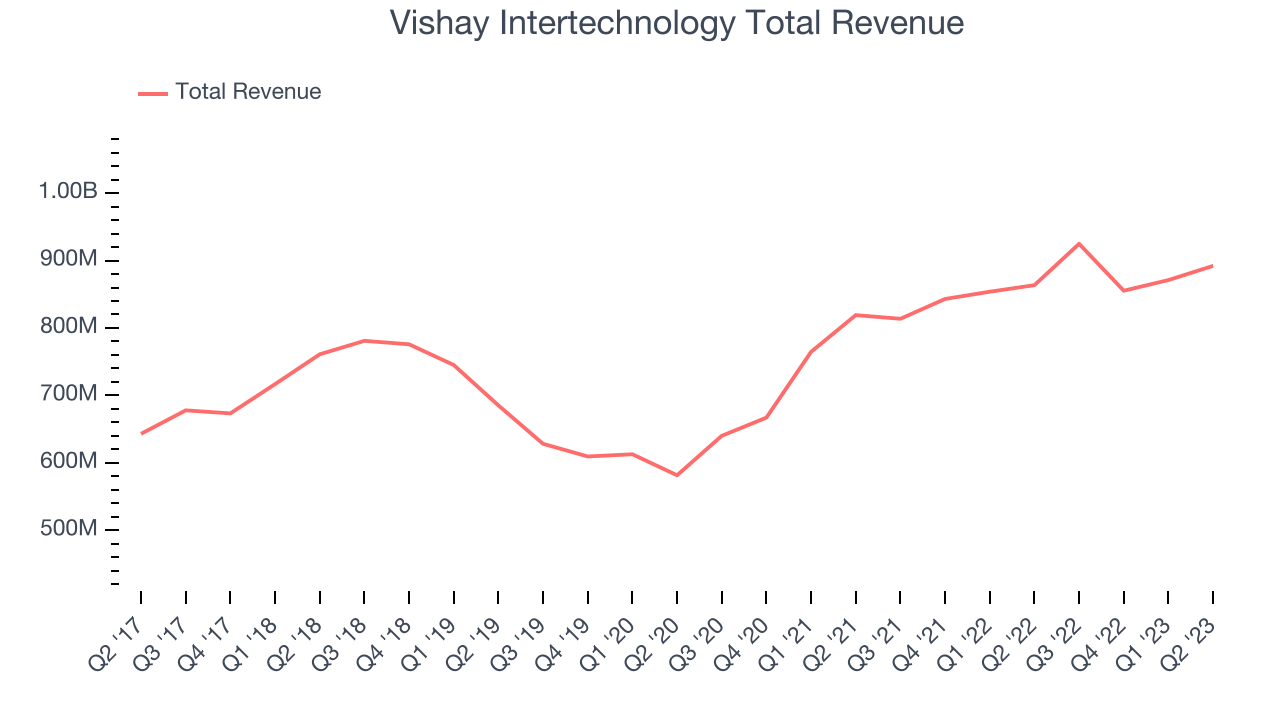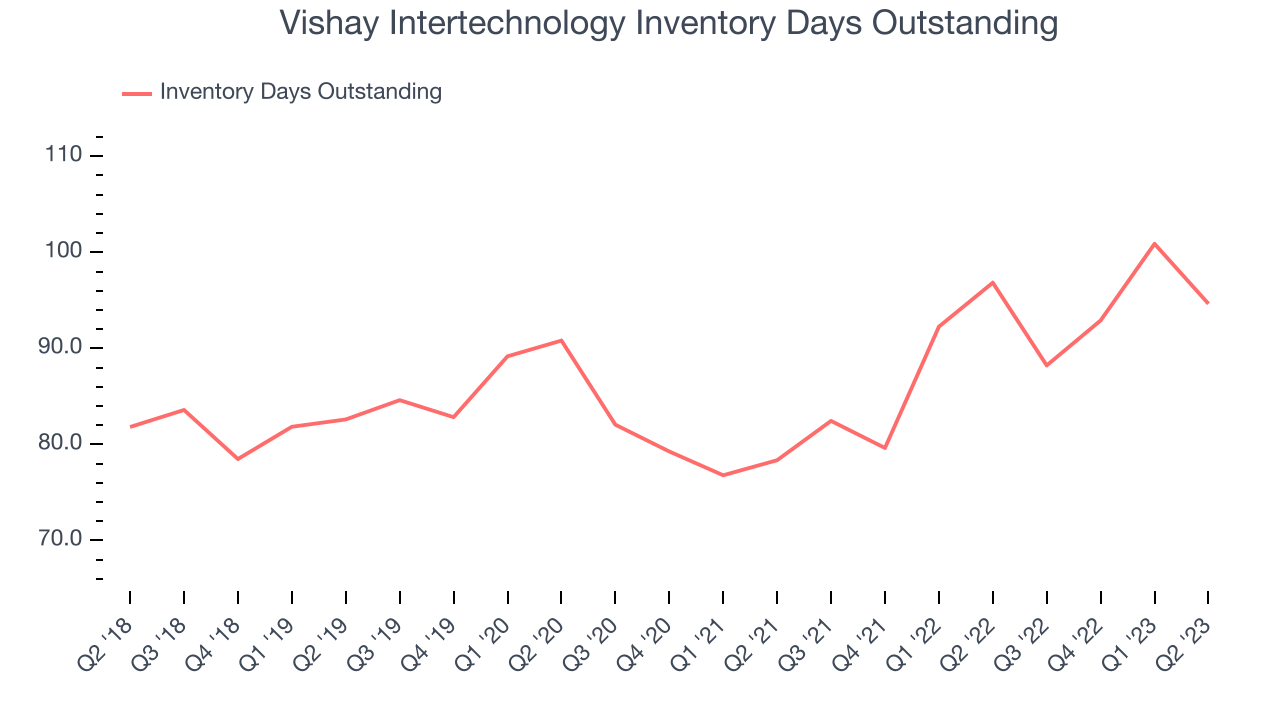Semiconductor manufacturer Vishay Intertechnology (NYSE:VSH) reported Q2 FY2023 results beating Wall Street analysts' expectations, with revenue up 3.31% year on year to $892.1 million. However, next quarter's revenue guidance of $860 million was less impressive, coming in 3.69% below analysts' estimates. Vishay Intertechnology made a GAAP profit of $95.4 million, down from its profit of $112.8 million in the same quarter last year.
Is now the time to buy Vishay Intertechnology? Find out by accessing our full research report, it's free.
Vishay Intertechnology (VSH) Q2 FY2023 Highlights:
- Revenue: $892.1 million vs analyst estimates of $881.8 million (1.17% beat)
- EPS (non-GAAP): $0.68 vs analyst estimates of $0.63 (7.51% beat)
- Revenue Guidance for Q3 2023 is $860 million at the midpoint, below analyst estimates of $893 million
- Free Cash Flow of $36.3 million, down 57.2% from the previous quarter
- Inventory Days Outstanding: 95, down from 101 in the previous quarter
- Gross Margin (GAAP): 28.9%, down from 31% in the same quarter last year
“For the second quarter Vishay posted solid results, with revenue increasing 2.4% over the first quarter and 3.3% over last year’s second quarter, reflecting sustained momentum in automotive end markets for Vishay products that support increased electronic content, ADAS features and EV production along with improved order flow for legacy automotive programs as supply chain bottlenecks have eased,” said Joel Smejkal, President and CEO.
Named after the founder's ancestral village in present-day Lithuania, Vishay Intertechnology (NYSE:VSH) manufactures simple chips and electronic components that are building blocks of virtually all types of electronic devices.
Demand for analog chips is generally linked to the overall level of economic growth, as analog chips serve as the building blocks of most electronic goods and equipment. Unlike digital chip designers, analog chip makers tend to produce the majority of their own chips, as analog chip production does not require expensive leading edge nodes. Less dependent on major secular growth drivers, analog product cycles are much longer, often 5-7 years.
Sales Growth
Vishay Intertechnology's revenue growth over the last three years has been mediocre, averaging 14% annually. As you can see below, this was a weaker quarter for the company, with revenue growing from $863.5 million in the same quarter last year to $892.1 million. Semiconductors are a cyclical industry, and long-term investors should be prepared for periods of high growth followed by periods of revenue contractions (which can sometimes offer opportune times to buy).

While Vishay Intertechnology beat analysts' revenue estimates, this was a sluggish quarter for the company as its revenue only grew 3.31% year on year. This marks 12 straight quarters of growth, showing that the current upcycle has had a good run, as a typical upcycle usually lasts 8-10 quarters.
Vishay Intertechnology's revenue is projected to contract next quarter, with the company guiding to a 7.01% year-on-year decline. On the other hand, analysts seem to disagree and forecast 0.28% revenue growth over the next 12 months.
While most things went back to how they were before the pandemic, a few consumer habits fundamentally changed. One founder-led company is benefiting massively from this shift and is set to beat the market for years to come. The business has grown astonishingly fast, with 40%+ free cash flow margins, and its fundamentals are undoubtedly best-in-class. Still, its total addressable market is so big that the company has room to grow many times in size. You can find it on our platform for free.
Product Demand & Outstanding Inventory
Days Inventory Outstanding (DIO) is an important metric for chipmakers, as it reflects a business' capital intensity and the cyclical nature of semiconductor supply and demand. In a tight supply environment, inventories tend to be stable, allowing chipmakers to exert pricing power. Steadily increasing DIO can be a warning sign that demand is weak, and if inventories continue to rise, the company may have to downsize production.

This quarter, Vishay Intertechnology's DIO came in at 95, which is 9 days above its five-year average. These numbers suggest that despite the recent decrease, the company's inventory levels are higher than what we've seen in the past.
Key Takeaways from Vishay Intertechnology's Q2 Results
With a market capitalization of $3.74 billion, Vishay Intertechnology is among smaller companies, but its $1.1 billion cash balance and positive free cash flow over the last 12 months give us confidence that it has the resources needed to pursue a high-growth business strategy.
We were impressed by how significantly Vishay Intertechnology blew past analysts' EPS expectations this quarter. We were also glad that its inventory levels shrunk. On the other hand, its revenue guidance for next quarter underwhelmed, coming in below expectations, and its gross margin shrunk. Gross margin guidance for next quarter was also below Wall Street analysts' expectations. Overall, this was a mixed quarter for Vishay Intertechnology. The stock is flat after reporting and currently trades at $27 per share.
Vishay Intertechnology may have had a tough quarter, but does that actually create an opportunity to invest right now? When making that decision, it's important to consider its valuation, business qualities, as well as what has happened in the latest quarter. We cover that in our actionable full research report which you can read here, it's free.
One way to find opportunities in the market is to watch for generational shifts in the economy. Almost every company is slowly finding itself becoming a technology company and facing cybersecurity risks and as a result, the demand for cloud-native cybersecurity is skyrocketing. This company is leading a massive technological shift in the industry and with revenue growth of 50% year on year and best-in-class SaaS metrics it should definitely be on your radar.
The author has no position in any of the stocks mentioned in this report.
